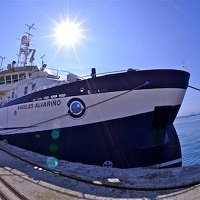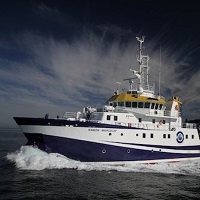Keyword
nutrient analysers
125 record(s)
Type of resources
Categories
Topics
INSPIRE themes
Keywords
Contact for the resource
Provided by
Years
Formats
Status
-

The goals of this campaign are framed within the objectives of the overall project 'Radial Profunda de Canarias', being the experimental cruise of the proposal. Thus, this cruise will help to: • Determine the structure of the current when it reaches the Canary Islands, mass transport, heat and nutrients and interannual variability. • Characterize the different modes of variability of heat and mass transport in easternorth atlantic subtropical gyre. • To determine the correlation between heat and mass transport with the NAO atmospheric and oceanic index. • Characterize the annual cycle in the physical conditions of the surface layers and mixture to where the seasonal cycle is significant, relating it to the meteorological forcings. • Characterization of changes in water masses, mainly in the North Atlantic Central Water (NACW), in Antarctic Atlantic Intermediate Water (AAIW) in Mediterranean Water (MW) and bottom waters of the Canary Basin, in based on temperature, salinity, nutrients and oxygen.
-

The goals of this campaign are framed within the objectives of the overall project 'Sevacan', being the experimental cruise of the proposal. Thus, this cruise will help to: • Determine the structure of the current when it reaches the Canary Islands, mass transport, heat and nutrients and interannual variability. • Characterize the different modes of variability of heat and mass transport in easternorth atlantic subtropical gyre. • To determine the correlation between heat and mass transport with the NAO atmospheric and oceanic index. • Characterize the annual cycle in the physical conditions of the surface layers and mixture to where the seasonal cycle is significant, relating it to the meteorological forcings. • Characterization of changes in water masses, mainly in the North Atlantic Central Water (NACW), in Antarctic Atlantic Intermediate Water (AAIW) in Mediterranean Water (MW) and bottom waters of the Canary Basin, in based on temperature, salinity, nutrients and oxygen.
-

The goals of this campaign are framed within the objectives of the overall project 'Radial Profunda de Canarias', being the experimental cruise of the proposal. Thus, this cruise will help to: • Determine the structure of the current when it reaches the Canary Islands, mass transport, heat and nutrients and interannual variability. • Characterize the different modes of variability of heat and mass transport in easternorth atlantic subtropical gyre. • To determine the correlation between heat and mass transport with the NAO atmospheric and oceanic index. • Characterize the annual cycle in the physical conditions of the surface layers and mixture to where the seasonal cycle is significant, relating it to the meteorological forcings. • Characterization of changes in water masses, mainly in the North Atlantic Central Water (NACW), in Antarctic Atlantic Intermediate Water (AAIW) in Mediterranean Water (MW) and bottom waters of the Canary Basin, in based on temperature, salinity, nutrients and oxygen.
-

The goals of this campaign are framed within the objectives of the overall project 'Radial Profunda de Canarias', being the experimental cruise of the proposal. Thus, this cruise will help to: • Determine the structure of the current when it reaches the Canary Islands, mass transport, heat and nutrients and interannual variability. • Characterize the different modes of variability of heat and mass transport in easternorth atlantic subtropical gyre. • To determine the correlation between heat and mass transport with the NAO atmospheric and oceanic index. • Characterize the annual cycle in the physical conditions of the surface layers and mixture to where the seasonal cycle is significant, relating it to the meteorological forcings. • Characterization of changes in water masses, mainly in the North Atlantic Central Water (NACW), in Antarctic Atlantic Intermediate Water (AAIW) in Mediterranean Water (MW) and bottom waters of the Canary Basin, in based on temperature, salinity, nutrients and oxygen.
-

Main targets: · ESTOC Observatory service - FixO3 · ESTOC time-series - Autonm sampling
-

The goals of this campaign are framed within the objectives of the overall project 'Sevacan', being the experimental cruise of the proposal. Thus, this cruise will help to: • Determine the structure of the current when it reaches the Canary Islands, mass transport, heat and nutrients and interannual variability. • Characterize the different modes of variability of heat and mass transport in easternorth atlantic subtropical gyre. • To determine the correlation between heat and mass transport with the NAO atmospheric and oceanic index. • Characterize the annual cycle in the physical conditions of the surface layers and mixture to where the seasonal cycle is significant, relating it to the meteorological forcings. • Characterization of changes in water masses, mainly in the North Atlantic Central Water (NACW), in Antarctic Atlantic Intermediate Water (AAIW) in Mediterranean Water (MW) and bottom waters of the Canary Basin, in based on temperature, salinity, nutrients and oxygen.
-

The objective of the DOS MARES project is twofold. First, we aim at understanding the effects of the atmospheric teleconnections between the Cantabrian Sea and the north-western Mediterranean Sea, and their impacts on the deep ecosystem, both pelagic and benthic. Second, we want to know in which way the transfer of the signal from the external forcings towards the deep ecosystem controls the community structure and the population dynamics. Thus, in March 2012 we deployed 6 mooring lines equipped with sediment traps and currentmeters in the Avilés and Gaviera canyons and the slope. In September 2012 the moorings were successfully recovered and redeployed again, and during this cruise DOSMARES BIOCANT3 they have been finally recovered and the 1-year monitoring effort finalised. In addition, CTD profiling has been performed to characterise the biological and physical structure of the water column (including the acquisition of discrete water samples), multicorers have been obtained to characterise the geochemical properties of surface sediments, and a multinet used to obtain macro- and meso-zooplankton community structure. Overall, data will allow to characterize the external forcings and abiotic conditions in the Cantabrian Sea, and thus establish the links between abiotic conditions, populations and pelagic and benthopelagic resources.
-

The objective of the DOS MARES project is twofold. First, we aim at understanding the effects of the atmospheric teleconnections between the Cantabrian Sea and the north-western Mediterranean Sea, and their impacts on the deep ecosystem, both pelagic and benthic. Second, we want to know in which way the transfer of the signal from the external forcings towards the deep ecosystem controls the community structure and the population dynamics. Thus, in March 2012 we deployed 6 mooring lines equipped with sediment traps and currentmeters in the Avilés and Gaviera canyons and the slope. In September 2012 the moorings were successfully recovered and redeployed again, and during this cruise DOSMARES BIOCANT3 they have been finally recovered and the 1-year monitoring effort finalised. In addition, CTD profiling has been performed to characterise the biological and physical structure of the water column (including the acquisition of discrete water samples), multicorers have been obtained to characterise the geochemical properties of surface sediments, and a multinet used to obtain macro- and meso-zooplankton community structure. Overall, data will allow to characterize the external forcings and abiotic conditions in the Cantabrian Sea, and thus establish the links between abiotic conditions, populations and pelagic and benthopelagic resources.
-

The objective of the project RADIALES, formulated in 1990, aims at “understanding and modelling the response of the marine ecosystem to the sources of temporal variability in oceanographic and planktonic components, particularly foccusing in those factors and processes affecting biological production and potentially altering the ecosystem services”. This project represents the oldest multidisciplinary ocean observation initiative still active in Spain.
-

Main objetive of the project VULCANA, is assess the degree of affection and recovery of the marine ecosystem of the submarine volcano of the island of El Hiello, extending it to any other region of the canary islands sensitive to underwater volcanic activity. For this purpose, the physical-chemical, biological and geological properties of the eruptive process will be monitored in the island of El Hierro and other sensitive places, giving continuity to the temporary series of multidisciplinary data of a monogenetic submarine volcano in Spanish waters.
 Catálogo de datos del IEO
Catálogo de datos del IEO